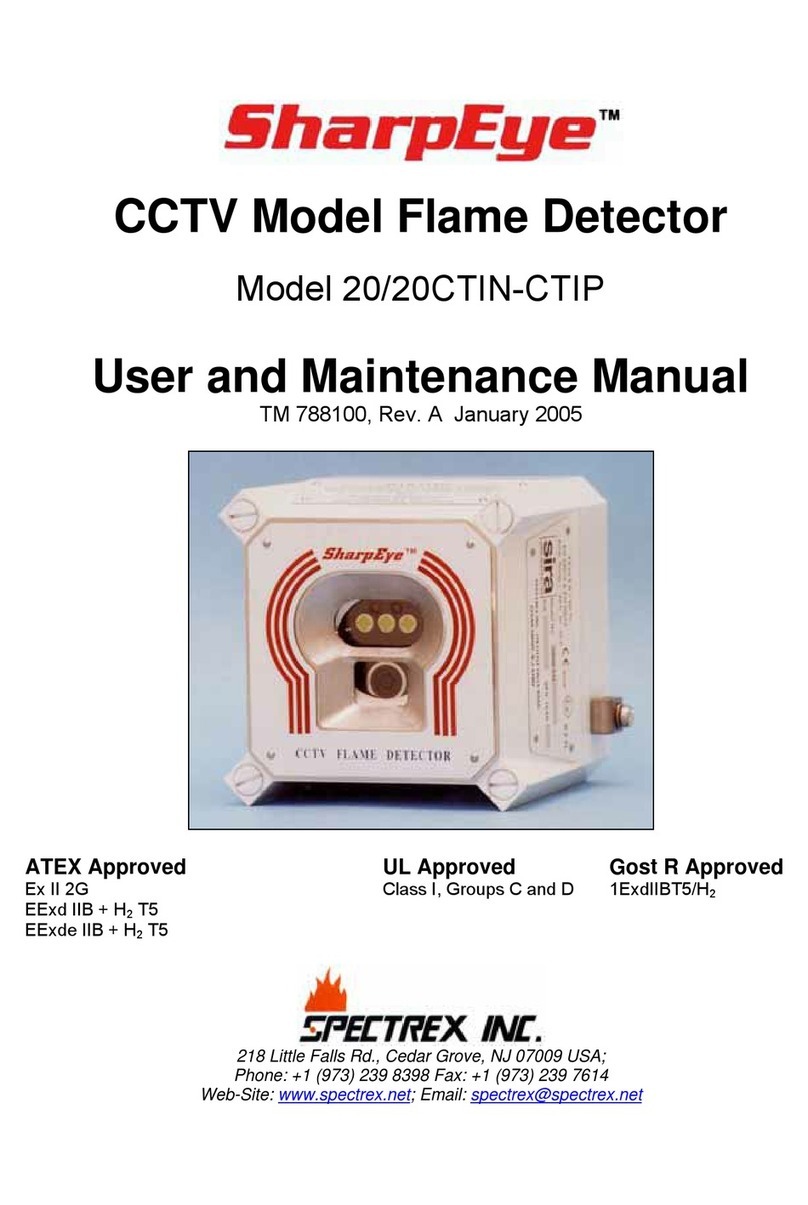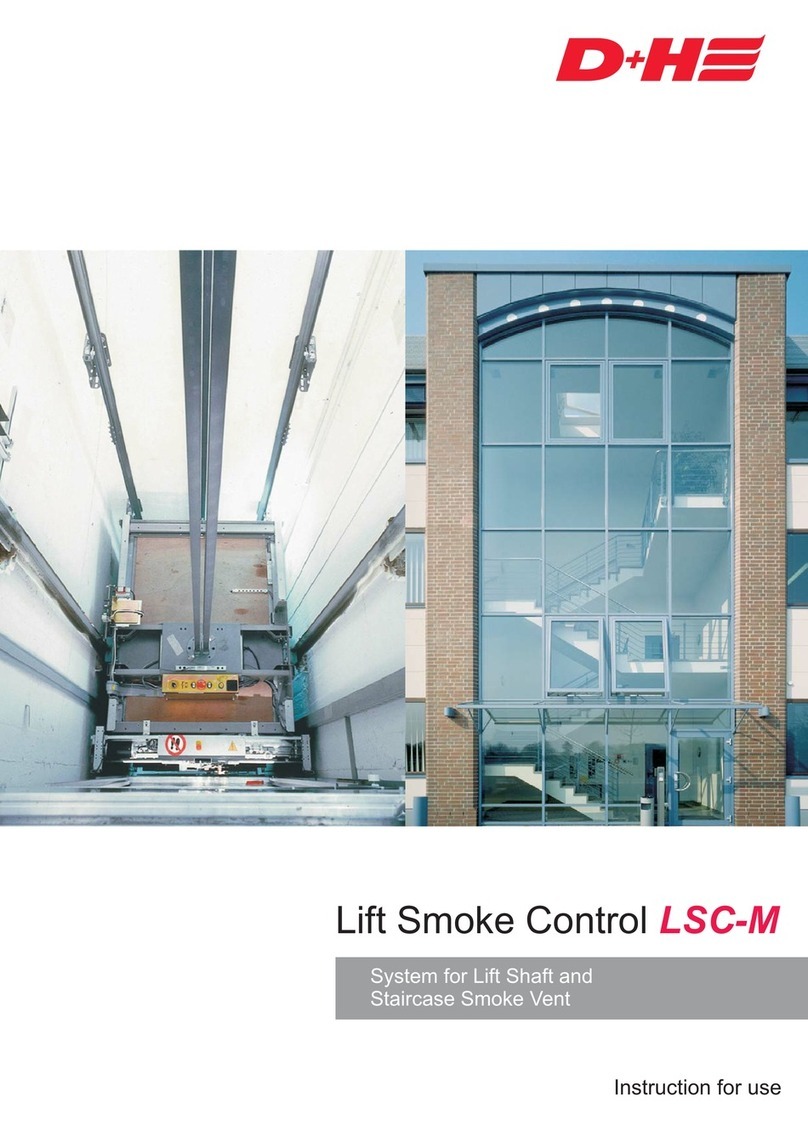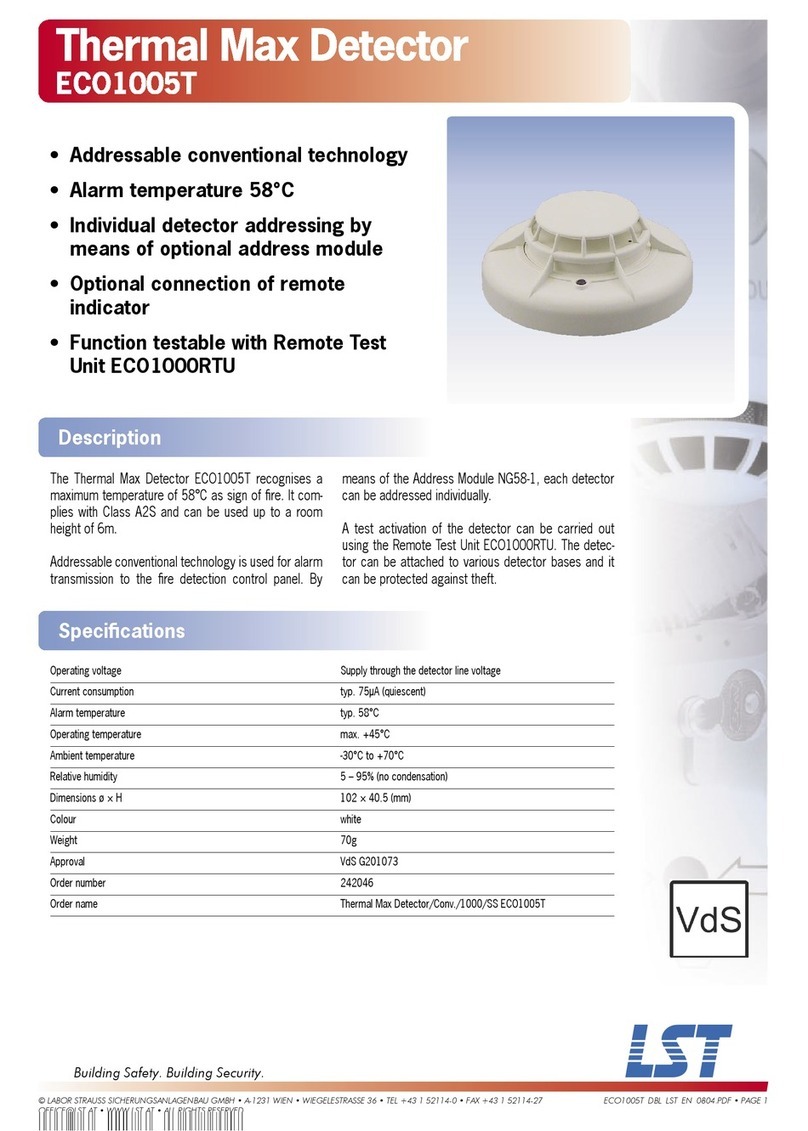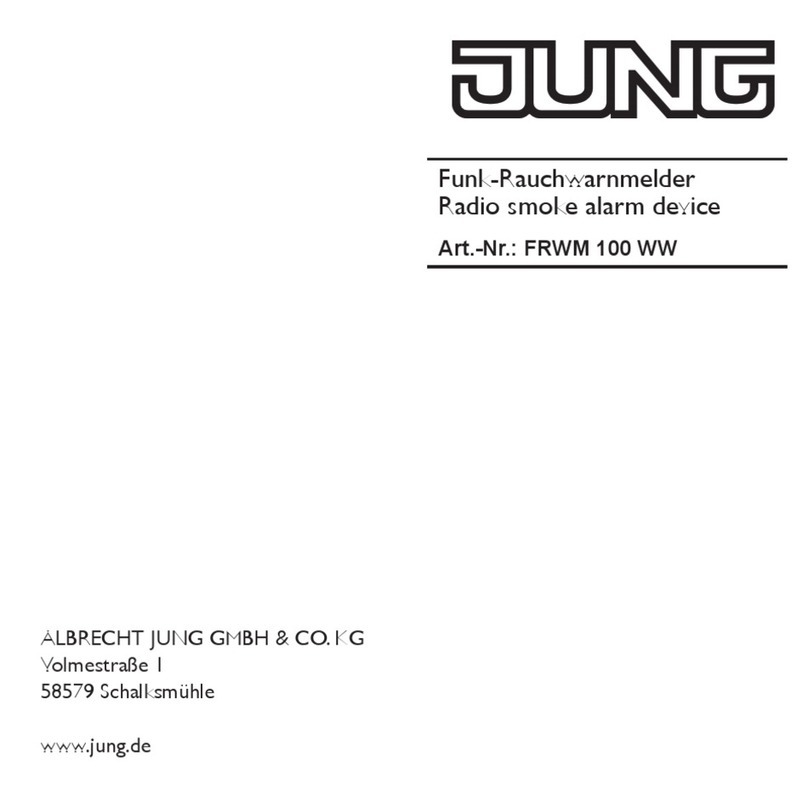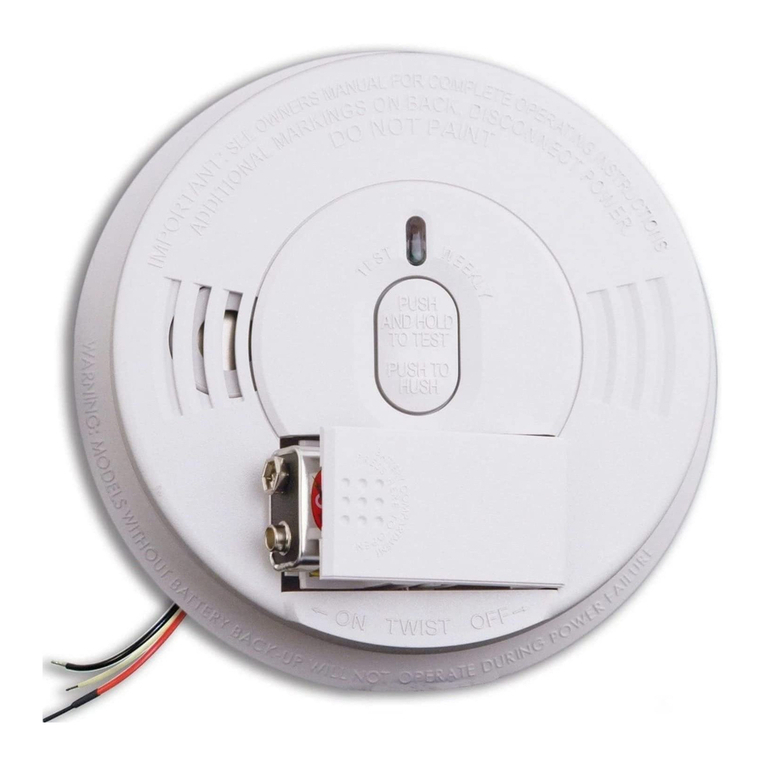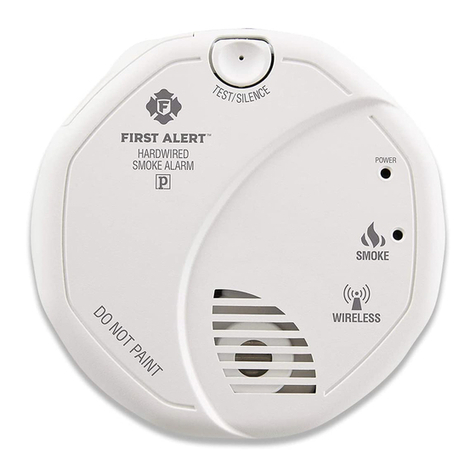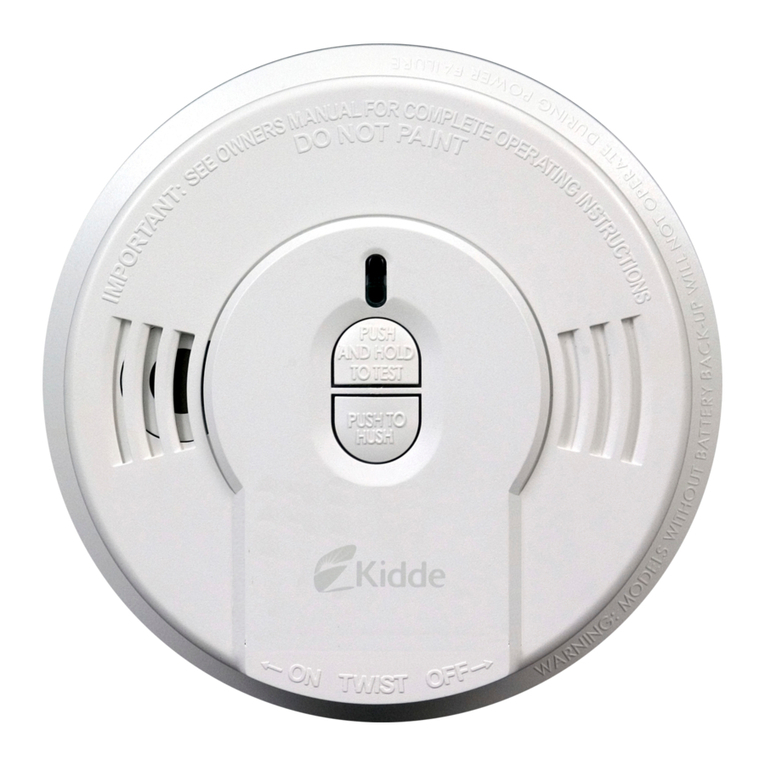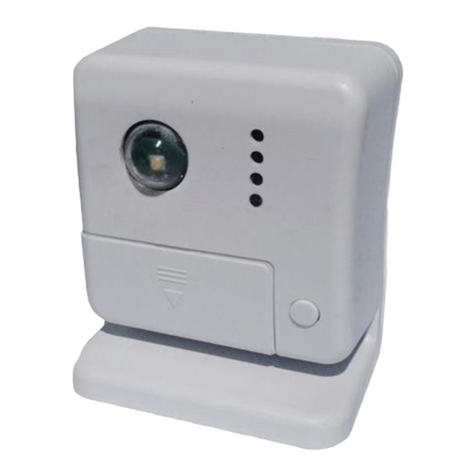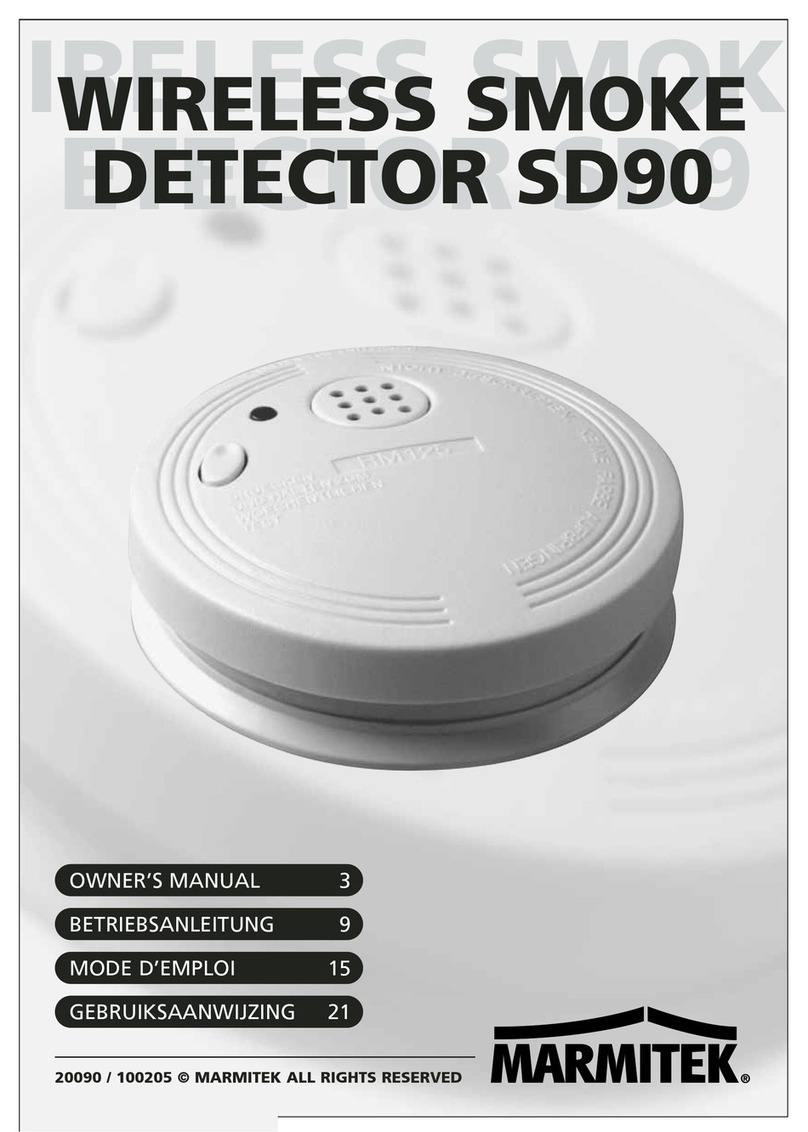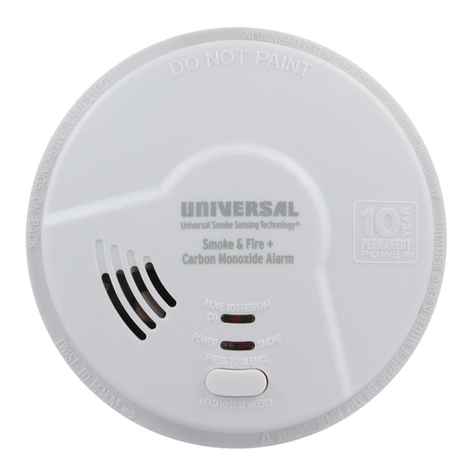SharpEye 20/20L Operating instructions

UV/IR Flame Detector
Model 20/20L-LB
User's and Maintenance Manual
TM20/20LB Rev E, August 2004
Factory Mutual Approved
Class I Div. 1 Groups B, C, D
Class II Div. 1 Groups E, F, G
ATEX Approved
Ex II 2G
EExd IIB + H2T5
EExde IIB + H2T5
218 Little Falls Rd., Cedar Grove, NJ 07009 USA;
Phone: +1 (973) 239 8398 Fax: +1 (973) 239 7614


The SharpEye Optical Flame Detector described in this document is the property
of Spectrex, Inc.
No part of the hardware, software or documentation may be reproduced,
transmitted, transcribed, stored in a retrieval system, or translated into any
language or computer language, in any form or by any means, without prior
written permission of Spectrex, Inc.
While great efforts have been made to assure the accuracy and clarity of this
document, Spectrex, Inc. assumes no liability resulting from any omissions in this
document, or from misuse of the information obtained herein. The information in
this document has been carefully checked and is believed to be entirely reliable
with all of the necessary information included. Spectrex Inc. reserves the right to
make changes to any products described herein to improve reliability, function, or
design, and reserves the right to revise this document and make changes from
time to time in content hereof with no obligation to notify any persons of revisions
or changes. Spectrex, Inc. does not assume any liability arising out of the
application or any use of any product or circuit described herein; neither does it
convey license under its patent rights or the rights of others.
Warning:
This manual should be carefully read by all individuals who have or will have
responsibility for using, maintaining or servicing the product.
The Detector is not field-repairable due to the meticulous alignment and
calibration of the sensors and the respective circuits. Do not attempt to modify or
repair the internal circuits or change their settings, as this will impair the system's
performance and void the Spectrex, Inc. Product warranty.


Spectrex Inc. - SharpEyeTM UV/IR Flame Detector Manual – TM20/20LB Rev E, August 2004
I
TABLE OF CONTENT
1. Scope................................................................................................................1
1.1 Product Overview ........................................................................................1
1.2 Document Overview ....................................................................................1
2. Technical Description........................................................................................2
2.1 Principles Of Operation ...............................................................................2
2.2 Sensing Elements .......................................................................................2
2.3 Detection Levels..........................................................................................3
2.4 Alarm Signal Delay......................................................................................3
2.5 Built-In-Test (BIT) Capabilities.....................................................................3
2.6 Detector Structure .......................................................................................4
2.7 System Configuration ..................................................................................4
2.8 Detector Types ............................................................................................4
3. Performance .....................................................................................................7
3.1 Detection Sensitivity ....................................................................................7
3.2 Cone Of Vision ............................................................................................9
3.3 False Alarms .............................................................................................10
4. Operation ........................................................................................................11
4.1 Visual Indications ......................................................................................11
4.2 Output Signals...........................................................................................11
4.3 Mode Selection..........................................................................................12
4.3.1 Function switch (SW1)........................................................................12
4.3.2 Alarm Delay Switch (SW2)..................................................................14
4.4 Detector States..........................................................................................15
4.5 Built-In-Test (refer to 2.5) .........................................................................16
5. Technical Specifications .................................................................................18
5.1 Electrical Specifications.............................................................................18
5.2 Mechanical Specifications .........................................................................20
5.3 Environmental Specifications ....................................................................21
6. Installation Instructions ...................................................................................22
6.1 Introduction................................................................................................22
6.2 General Considerations.............................................................................22
6.3 Preparations For Installation......................................................................23
6.4 Conduit Installation....................................................................................23
6.5 Detector Mounting .....................................................................................24
6.5.1 Swivel Mount Kit .................................................................................24
6.5.2 Swivel installation (Figure 4a and 4b) .................................................24
6.6 Wiring (Refer to Fig. 5) ..............................................................................27
6.7 Terminal Wiring (Figures 6,7) ....................................................................28
6.8 Selection Of Operating Modes ..................................................................32
7. Operating Instructions.....................................................................................33
7.1 Scope ........................................................................................................33
7.2 Power-Up ..................................................................................................33
7.3 Reset.........................................................................................................33
7.4 Functional Testing .....................................................................................34

Spectrex Inc. - SharpEyeTM UV/IR Flame Detector Manual – TM20/20LB Rev E, August 2004
II
7.5 Testing With Fire Simulator (See Appendix D) ..........................................34
7.6 Safety Precautions ....................................................................................35
8. Maintenance Instructions ................................................................................36
8.1 Scope ........................................................................................................36
8.2 Maintenance Instrumentation And Personnel............................................36
8.3 Preventive Maintenance Procedures.........................................................36
8.4 Periodic Maintenance Procedures.............................................................36
8.4.1 Power Up Procedure ..........................................................................36
8.4.2 Functional Test Procedure..................................................................36
8.5 Maintenance Records ...............................................................................37
8.6 Troubleshooting.........................................................................................37
8.6.1 Fault Indication ...................................................................................37
8.6.2 False Alarm or Warning Indication......................................................37
Appendix A - Wire Selection Tables....................................................................39
Appendix B. Typical Wiring Configurations .........................................................41
Appendix C. Mounting the “EExde approved” version ........................................43
Appendix D. Long Range UV/IR Fire Simulator ..................................................47

Spectrex Inc. - SharpEyeTM UV/IR Flame Detector Manual – TM20/20LB Rev E, August 2004
III
LIST OF FIGURES
Figure 1. Flame Detector Assembly - Outline Drawing..................................................... 5
Figure 2. Flame Detector Assembly - Schematic Section................................................... 6
Figure 3. Horizontal and Vertical Fields of View.............................................................. 9
Figure 4.a. U/IR Detector and Swivel Mount Assembly................................................... 25
Figure 4.b. Swivel Mount Assembly.................................................................................. 26
Figure 5. UV/IR Flame Detector with Cover Removed....................................................29
Figure 6. Terminal Board Configuration ......................................................................... 30
Figure 7. Flame Detector Assembly - Wiring Diagram ................................................... 31
Figure 8. Typical Wiring Diagram for Four-Wire Controller ......................................... 41
Figure 9. Wiring Diagram for 4-20mA............................................................................. 41
Figure 10: Flame Detector Assembly - Wiring Diagram................................................. 45
Figure 11: OPTION A Flame Detector Assembly - Wiring Diagram (“de version”).....46
Figure 12: OPTION B Flame Detector Assembly - Wiring Diagram (“de version”).....46
Figure 13: Fire Simulator................................................................................................. 47
Figure 14: UV/IR Detector Target Point..........................................................................48
LIST OF TABLES
Table 1. Response Sensitivity Ranges................................................................................. 8
Table 2. Immunity to False Alarm Faults......................................................................... 10
Table 3. LED indications within different detector states................................................ 11
Table 4. Function Switch SW1.......................................................................................... 12
Table 5. SW2 Alarm Delay Setting ................................................................................... 14
Table 6. Output Signals Versus Detector State.................................................................15
Table 7. Dry Contacts Relays Ratings.............................................................................. 19
Table 8: Mounting according to US Version....................................................................24
Table 9: Mounting according to EU Version ................................................................... 24
Table 10. Maximum DC resistance at 68°F for copper wire............................................ 39
Table 11. Wiring length in feet (meter)............................................................................. 39
Table 12. Terminals wiring options of the detector..........................................................46

Spectrex Inc. - SharpEyeTM UV/IR Flame Detector Manual – TM20/20LB Rev E, August 2004
IV

Spectrex Inc. - SharpEyeTM UV/IR Flame Detector Manual – TM20/20LB Rev E, August 2004
1
1. Scope
1.1 Product Overview
The Spectrex Model 20/20L, 20/20LB is a UV-IR Flame Detector. It is designed
to sense the occurrence of fire and flames and subsequently activate an alarm or
an extinguishing system directly or through a control circuit for maximum fire
protection. It uses innovative technology of advanced digital signal processing to
analyze the dynamic characteristics of fire.
The difference between the Models is that Model 20/20LB includes a Built In Test
(BIT) function while the model 20/20L does not.
Detection performance is controlled by a microprocessor and easily adapted to
all environments, applications and requirements. The result is a unique and
superior flame detector that provides excellent detection sensitivity with extreme
immunity to false alarm.
1.2 Document Overview
This manual describes the detector and its features. It describes instructions on
the installation, operation and maintenance.
This manual is divided into several parts. Each part is contained in a separate
chapter as follows:
Chapter 1. Scope. A general introduction and overview of the product and the
Manual with a brief description of its content.
Chapter 2. Technical Description - the detector’s theory of operation.
Chapter 3. Performance - the detector features and capabilities.
Chapter 4. Operation modes, user interface and indications.
Chapter 5. Technical Specifications Detector’s electrical, mechanical and
environmental specifications.
Chapter 6. Installation Instructions including wiring and mode setting.
Chapter 7. Operating Instructions and power-up procedures.
Chapter 8. Maintenance Instructions and support procedures.
Appendix A. Wiring Selection Tables for electrical wire selection according to
installation configuration.
Appendix B. Typical Wiring Configurations provides wiring diagrams for
installation.
Appendix C. Mounting the “EExde approved” version
Appendix D. Long Range UV/IR Fire Simulator

Spectrex Inc. - SharpEyeTM UV/IR Flame Detector Manual – TM20/20LB Rev E, August 2004
2
2. Technical Description
• Detection Range: Up to 50 ft (15m) for a 1ft x 1ft (0.3m x 0.3m) Gasoline
fire.
• Ultra High Immunity to False Alarm (see section. 3.3.).
• Advanced Digital Processing of the Dynamic Characteristics of Fire:
Flickering and threshold
• Dual Spectrum: UV and IR radiation
• Multiple Detection Levels: Warning, alarm and saturated signal
• Solar Blind
• Microprocessor Based: Microcontroller performs signal processing
• Built-In-Test: Manual and automatic BIT for 20/20LB only
(see section 4.5)
• Electrical Interface:
o Dry contact RELAYS.
o 4-20mA outputs.
2.1 Principles Of Operation
The Model 20/20L, 20/20LB Radiation Flame Detector is an electronic device
designed to sense the occurrence of fire and flames and subsequently activate
an alarm or an extinguishing system directly or through a control circuit.
The UV-IR Radiation Flame Detector is a dual spectrum optical detector sensitive
to two separate ranges of the radiation spectrum, both of which are present in
fires. The detector monitors the protected volume, by measuring the radiation
intensity in it, within two frequencies ranges of the electromagnetic spectrum,
namely the Ultra-Violet (UV) and the Infra-Red (IR).
The detector integrates two dependent channels in which appropriate detection
pulses are registered and further analyzed for frequency, intensity and duration.
2.2 Sensing Elements
The IR sensor is sensitive to radiation over the range of 2.5-3.0 micron. The IR
channel will register a detection signal, at the appropriate level, when the IR
sensor is exposed to radiation in the appropriate frequency range, having an
intermittent gleam pattern characteristic to flickering-fire, and a preset threshold
and time duration are reached.
The UV sensor is sensitive to radiation over the range of 0.185-0.260 micron.
The UV channel incorporates a special logic circuit that eliminates false alarms
caused by solar radiation and other non-fire UV sources. Further more; the UV
channel sensitivity is stabilized over the working temperature range.

Spectrex Inc. - SharpEyeTM UV/IR Flame Detector Manual – TM20/20LB Rev E, August 2004
3
2.3 Detection Levels
Simultaneous detection of radiation in both the UV and the IR channels having
an intensity, which exceeds detector’s preset Warning level, will result in a
Warning signal.
In addition, the detector includes an option that detection of UV radiation at high
intensity will result in a Warning Signal.
Simultaneous detection of radiation in both the UV and the IR channels having
an intensity, which exceeds detector’s preset Alarm level, will result in an Alarm
signal.
Simultaneous detection of radiation in both the UV and the IR channels having
an intensity which exceeds detector’s preset Flash-Fire Detection level will result
in an immediate Alarm signal, regardless of the detector mode setting selected.
Since the preset dual range and level of radiation, as well as the flickering
pattern, are characteristic of real fire, all other radiation sources apart from actual
fire will not be detected, thus avoiding false alarms.
2.4 Alarm Signal Delay
The detector is adapted with an Alarm Signal delay selector, allowing the user to
set a different delay between 0 to 30 seconds, mandatory for several specific
applications.
When Alarm level detection conditions are met, an internal time delay is initiated
as preset on the selector. Once the preset time delay has elapsed, detection
conditions are evaluated for 3 seconds. If during that evaluation period Alarm
level detection conditions persist, the Alarm signal is triggered. If no Alarm level
detection conditions endure, the Alarm signal Delay is reset.
2.5 Built-In-Test (BIT) Capabilities
The detector (only 20/20LB) is adapted with Built-In-Test (BIT) capabilities. The
BIT is continuously performs at predetermined time intervals averaging 60
minutes. It performs automatic full-featured test of the detector’s internal electric
circuits, and checks the radiation sensors and the detector window’s cleanliness.
The BIT circuits will generate response signals to indicate satisfactory operation
of the detector or a fault should it be detected during a BIT sequence. The BIT
sequence can also be initiated manually by the user at his preference, upon a
remote operation from a control unit.

Spectrex Inc. - SharpEyeTM UV/IR Flame Detector Manual – TM20/20LB Rev E, August 2004
4
2.6 Detector Structure
Figure 1 presents an outline drawing of the Flame Detector Assembly.
Figure 2 presents a schematic section of the internal Flame Detector, and
describes its main components.
2.7 System Configuration
The Spectrex model 20/20L, 20/20LB is a self-contained Optical Flame Detector
that can function as a stand alone unit directly connected to external devices as
alarm systems or automatic fire extinguishing systems. The same detector can
form part of a more complex system where a plurality of detectors and other
devices are integrated through a dedicated control unit.
2.8 Detector Types
This manual covers two types of detectors. Model 20/20LB and model 20/20L,
the difference is that Model 20/20LB includes a BIT and 20/20L does not include
this feature.
Both models are available in either Aluminum (Al.) housing, or Stainless Steel
(St.St.) housing.
There is an option for higher ambient temperature 185°F (+85°C) version if
specified.

Spectrex Inc. - SharpEyeTM UV/IR Flame Detector Manual – TM20/20LB Rev E, August 2004
5
Figure 1. Flame Detector Assembly - Outline Drawing

Spectrex Inc. - SharpEyeTM UV/IR Flame Detector Manual – TM20/20LB Rev E, August 2004
6
Figure 2. Flame Detector Assembly - Schematic Section
Note 1: This figure describes the Detector, which includes Ground Terminal for
ATEX installation. For FM installation device, which includes 1/4”
thread for external grounding screw mounting.
Note 2: Conduit/cable entries - standard size is 3/4”-14NPT or M25 as
specified at time of order

Spectrex Inc. - SharpEyeTM UV/IR Flame Detector Manual – TM20/20LB Rev E, August 2004
7
3. Performance
3.1 Detection Sensitivity
Detection sensitivity is the maximum distance at which the detector will reliably
detect a specific size of fire & typical type of fuel (standard fire).
Standard Fire:
Standard fire is defined as a 1ft x 1ft (0.3m x 0.3m) Gasoline pan fire with max.
Wind speed of 6.5ft/sec (2m/sec).
Sensitivity Ranges:
The detector has three response levels:
1. Warning (Pre-alarm)
2. Alarm
3. Saturated Signal
For some typical ambient conditions the Zeta parameter as defined in NFPA 72
for the detector is 0.01 (1/meter).
Note:
Zeta parameters may vary significantly with changes in temp, air pressure,
humidity, visibility conditions, etc.
Response Time:
The typical response time of the detector is 3 seconds for 1 sq. ft. gasoline fire,
and 20 msecs for saturated signal, which is defined as a 5” diameter Gasoline
fire from a distance of 12”.

Spectrex Inc. - SharpEyeTM UV/IR Flame Detector Manual – TM20/20LB Rev E, August 2004
8
Other Fuels:
The Detector will react to other fuels in standard fire conditions at maximum
response time of 3 seconds.
The sensitivity range to other fuels varies according to the fuel type. Table 1
below provides the sensitivity to other fuels relative to (as a percentage of) the
sensitivity to a standard gasoline fire source.
Table 1. Response Sensitivity Ranges
Type of Fuel % of Max. Distance at Each
Sensitivity Range
Gasoline 100%
N-Heptane 100%
Alcohol 95% 75%
JP4 75%
Kerosene 75%
Diesel Fuel 75%
Methane Fire* 30%
Propane Fire* 30%
* 0.5m plume fire

Spectrex Inc. - SharpEyeTM UV/IR Flame Detector Manual – TM20/20LB Rev E, August 2004
9
3.2 Cone Of Vision
Horizontal: 90°
Vertical: 90°
Figure 3 illustrates the relative range as a function of the incidence angle.
Figure 3. Horizontal and Vertical Fields of View

Spectrex Inc. - SharpEyeTM UV/IR Flame Detector Manual – TM20/20LB Rev E, August 2004
10
3.3 False Alarms
The detector does not provide an alarm or a warning signal as a reaction to the
radiation sources specified at Table 2 below.
Notes:
IAD = Immune at any distance.
All sources are chopped from 0 to 20 Hz.
Table 2. Immunity to False Alarm Faults
Radiation Source Immunity
Distance ft. (m)
Sunlight IAD
Indirect or reflected sunlight IAD
Vehicle headlights (low beam) conforming to MS53023-1 IAD
Incandescent frosted glass light, 100W IAD
Incandescent clear glass light, rough service, 100W IAD
Fluorescent light with white enamel reflector, standard office
or shop, 40W (or two 20W)
IAD
Arc welding [4mm (5/32in) rod; 240A] 9.8ft (3m)
Bright colored clothing, including red and safety orange IAD
Electronic flash (180 watt seconds minimum output) IAD
Red dome light conforming to M251073-1 IAD
Blue-green dome light conforming to M251073-1 IAD
Flashlight (Mx 991/U) IAD
Radiation heater, 1500W IAD
Radiation heater, 1000W with fan IAD
Grinding metal 3.3ft (1m)
Lit cigar or cigarette IAD
Match, wood, stick including flare up 3.3ft (1m)

Spectrex Inc. - SharpEyeTM UV/IR Flame Detector Manual – TM20/20LB Rev E, August 2004
11
4. Operation
4.1 Visual Indications
Two indication LEDs are located in the detector’s front window.
Yellow LED - Provides indication of Normal or Fault state.
Red LED - Provides indication of Warning or Alarm state.
Table 3. LED indications within different detector states
Detector State Yellow LED Red LED
Normal Blink at 0.5Hz Rate Off
Fault or BIT Fault Blink at 2Hz Rate Off
Warning Blink at 0.5Hz Rate Blink at 2Hz Rate
Alarm Blink at 0.5Hz Rate On
Warning at BIT Fault Blink at 2Hz Rate Blink at 2Hz Rate
Alarm at BIT Fault Blink at 2Hz Rate On
4.2 Output Signals
The detector includes the following control outputs:
• Alarm Relay
• Accessory Relay
• Fault Relay
• 4-20mA Current Source Output

Spectrex Inc. - SharpEyeTM UV/IR Flame Detector Manual – TM20/20LB Rev E, August 2004
12
4.3 Mode Selection
The detector has 2 DIPswitches, which enables the user to adapt the detector’s
operation to specific applications:
• Function switch (SW1)
• Alarm Delay Switch (SW2)
4.3.1 Function switch (SW1)
The user can select the desired mode of operation by means of this switch
according to Table 4.
Table 4. Function Switch SW1
SW ON Position OFF Position
1 Alarm Signal Latching enabled.
Reset of the Alarm signal is
performed by momentary
disconnection of power supply or
manual BIT activation.
Alarm Signal Latching disabled
(default).
2 Automatic & Manual BIT can be
performed (default).
Only Manual BIT can be
performed.
3 High UV protection enabled. High UV protection disabled
(default).
4 Accessory Relay used by the
Warning level.
Accessory Relay used in parallel to
the Alarm Relay (default).
5 Warning conditions: UV & IR at
Warning level, or UV at high level.
Warning conditions:
UV & IR at Warning level (default).
6 Following a successful Manual BIT
sequence:
Alarm Relay is activated and the
4-20mA output turns to 20mA for
approximately 3 seconds (default).
Following a successful Manual BIT
sequence (1),(2):
Alarm Relay is not activated
7 Following a successful Manual BIT
sequence (2):
Accessory Relay is activated and the
4-20mA output turns to 16mA for
approximately 3 seconds(3) (default).
Following a successful Manual BIT
sequence(2):
Accessory Relay is not activated.
8 Accessory Relay used as EOL relay. Accessory Relay function in
accordance with the position of
SW1-4 (default).
Notes:
1 The BIT sequence may last up to 7 seconds. Verify that all eight (8) switches
are in the appropriate setting (ON/OFF), to achieve the required functional
mode of operation.
2 SW1-2, SW1-6, SW1-7 are function only for model 20/20LB. Model 20/20L
does include BIT.
3 If both SW1-6 and SW1-7 are at on position the 4-20mA output is 20mA
(Alarm Level) after successful manual BIT.
This manual suits for next models
2
Table of contents
Other SharpEye Smoke Alarm manuals
Popular Smoke Alarm manuals by other brands
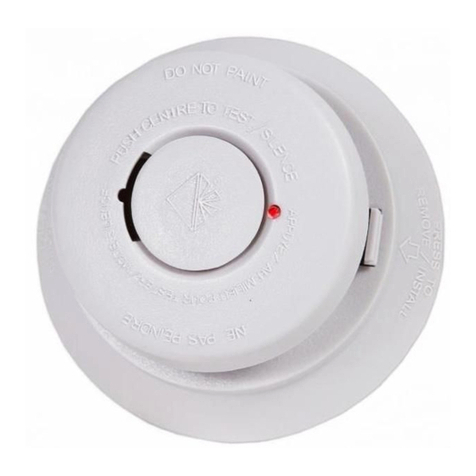
Elmes Electronic
Elmes Electronic MTS-166/9V quick start guide

Fire-Lite Alarms
Fire-Lite Alarms 1400 quick start guide
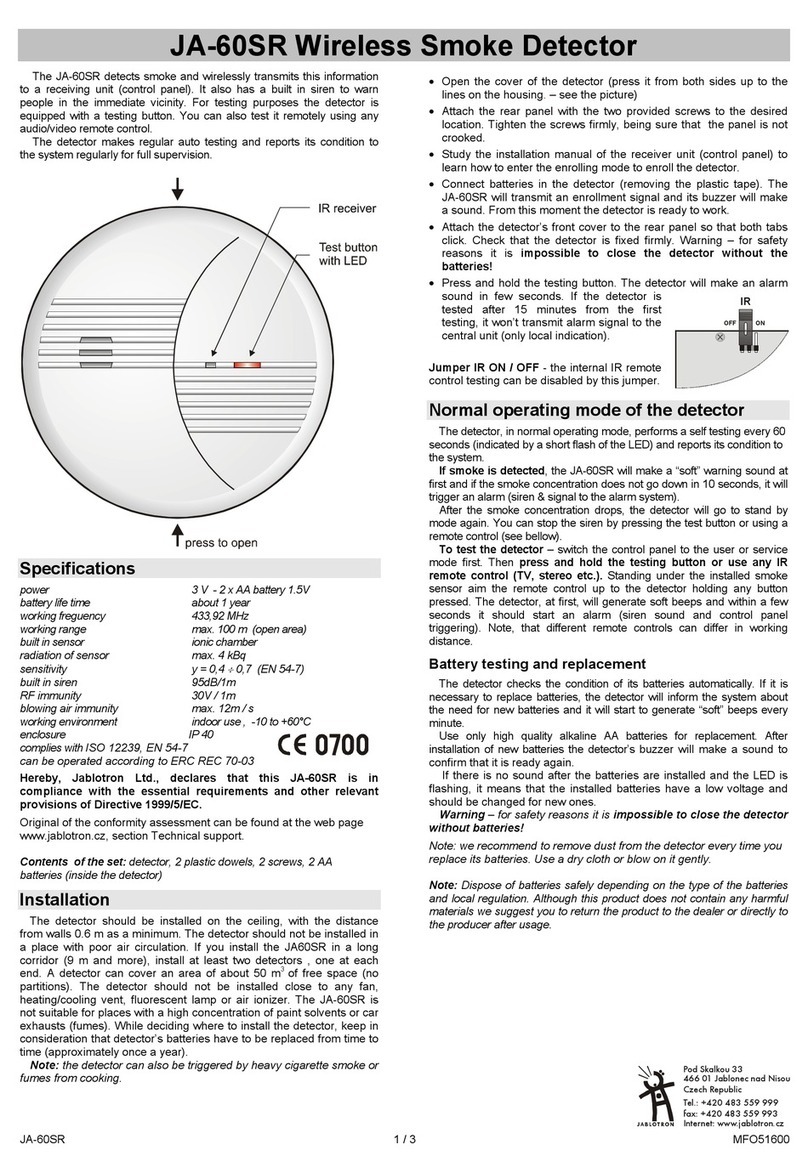
jablotron
jablotron JA-60SR quick start guide
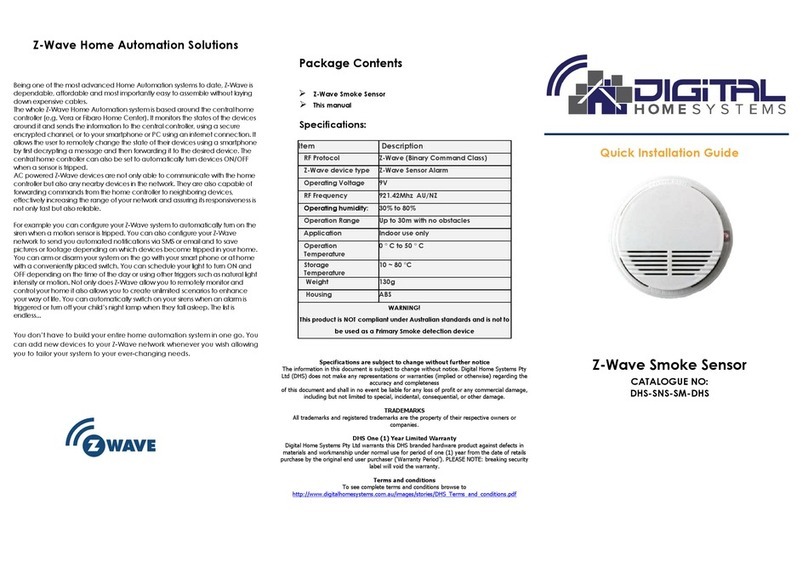
Digital Home Systems
Digital Home Systems DHS-SNS-SM-DHS Quick installation guide
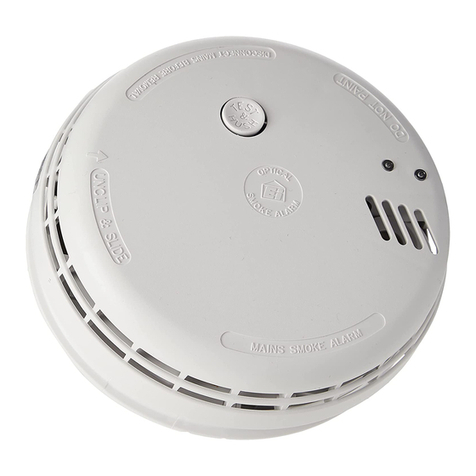
Ei Electronics
Ei Electronics Ei141RC - Ionisation User instructions
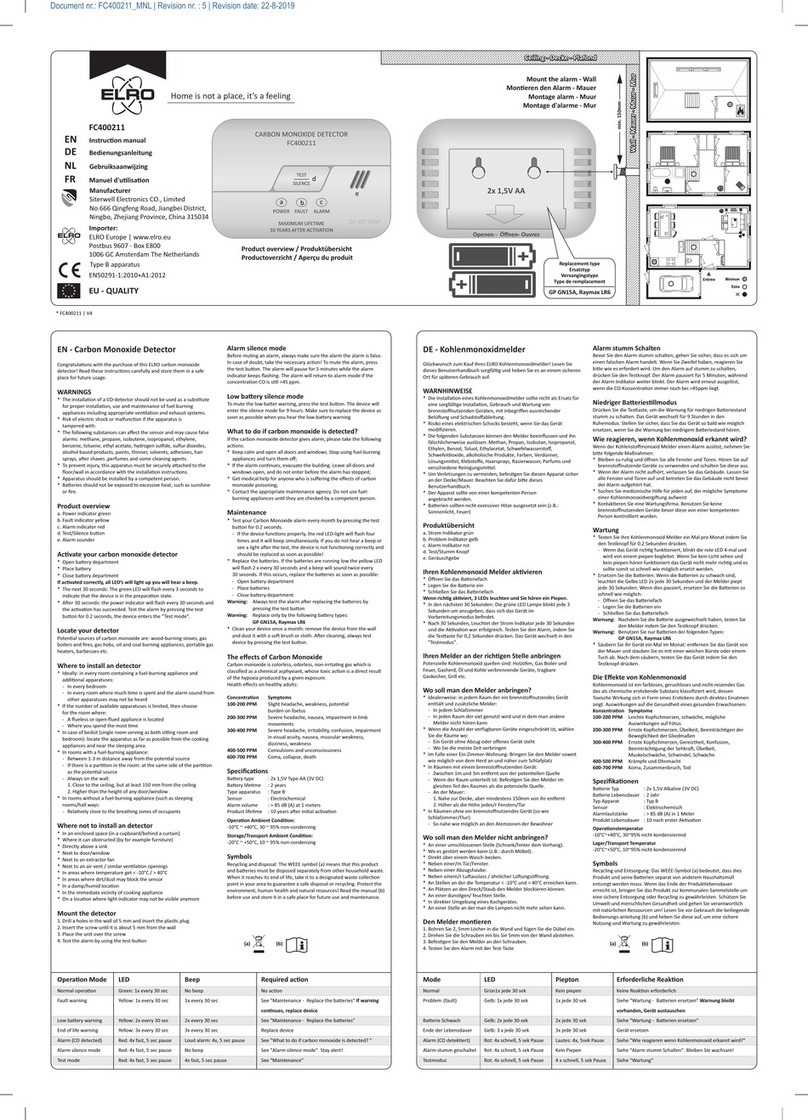
ELRO
ELRO FC400211 instruction manual
